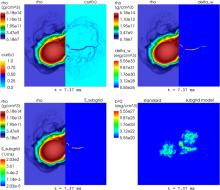
Abstract
The merger of binary neutron stars (BNSs) can lead to large amplifications of the magnetic field due to the development of turbulence and instabilities in the fluid, such as the Kelvin–Helmholtz shear instability, which drive small-scale dynamo activity. In order to properly resolve such instabilities and obtain the correct magnetic field amplification, one would need to employ resolutions that are currently unfeasible in global general relativistic magnetohydrodynamic simulations of BNS mergers. Here, we present a subgrid model that allows global simulations to take into account the small-scale amplification of the magnetic field which is caused by the development of turbulence during BNS mergers. Assuming dynamo saturation, we show that magnetar-level fields ( ) can be easily reached, and should therefore be expected from the merger of magnetized BNSs. The total magnetic energy can reach values up to
) can be easily reached, and should therefore be expected from the merger of magnetized BNSs. The total magnetic energy can reach values up to  and the post-merger remnant can therefore emit strong electromagnetic signals and possibly produce short gamma-ray bursts.
and the post-merger remnant can therefore emit strong electromagnetic signals and possibly produce short gamma-ray bursts.